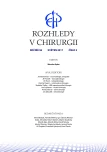Combined treatment of early tracheobronchopleural fistula after right tracheal sleeve pneumonectomy
Authors:
J. Hanuliak; M. Szkorupa; J. Chudáček; M. Stašek; Č. Neoral
Authors‘ workplace:
I. chirurgická klinika FN Olomouc
přednosta: prof. MUDr. Č. Neoral, CSc.
Published in:
Rozhl. Chir., 2017, roč. 96, č. 5, s. 213-217.
Category:
Case Report
Overview
Extended tracheo-bronchoplastic resection for lung cancer with carinal involvement ranks among technically demanding procedures. Despite certain progress in oncological therapy, this type of resection remains the only potentially curative treatment of NSCLC in this localization. However, given the severity of complications postoperative mortality is relatively high (7−11%). The main cause of death is tracheobronchopleural fistula complicated by thoracic empyema, bronchopneumonia and septic shock. If ARDS (acute respiratory distress syndrome) develops, the mortality rate rises up to 70%. The treatment of tracheobronchopleural fistula is arduous, long-term and essentially multidisciplinary.
In this case report, the authors present the case of a 58 years old patient developing the tracheobronchopleural fistula early after carinal resection and sleeve pneumonectomy for a centrally localised squamous cell carcinoma of the right lung. The fistula was primarily sutured and secured using a muscular flap. For recurrence of the fistula, tissue adhesive glue was applied in combination with the introduction of a plastic stent, which resulted in healing of the tracheobronchopleural fistula.
Key words:
sleeve pulmonectomy − carinal resection − tracheobronchopleural fistula − tracheobronchial stenting
Sources
1. Stolz AJ, Pavel P. Komplikace v hrudní chirurgii. 1. vyd. Praha, Grada 2010:237.
2. Cerfolio RJ. The incidence, etiology, and prevention of postresectional bronchopleural fistula. Semin Thorac Cardiovasc Surg. 2001;13:3−7.
3. Clagett OT, Geraci JE. A procedure for the management of postpneumonectomy empyema. J. Thorac. Cardiovasc. Surg 1963;45:141–5.
4. Renner C, Reschke S, Richter W. Thoracic empyema after pneumonectomy: intrathoracic application of vacuum-assisted closure therapy. Ann Thorac Surg 2010;89:603−4.
5. Sivrikoz CM, Kaya T, Tulay CM, et al. Effective approach for the treatment of bronchopleural fistula: application of endovascular metallic ring-shaped coil in combination with fibrin glue. Ann Thorac Surg 2007;83:2199–201.
6. Andreetti C, D‘Andrilli A, Ibrahim M, et al. Effective treatment of post-pneumonectomy bronchopleural fistula by conical fully covered self-expandable stent. Interact Cardiovasc Thorac Surg 2012;14:420−3.
7. Dutau H, Breen DP, Gomez C, et al. The integrated place of tracheobronchial stents in the multidisciplinary management of large post-pneumonectomy fistulas: our experience using a novel customised conical self-expandable metallic stent. Eur J Cardiothorac Surg 2011;39:185–9.
8. Watanabe S, Shimokawa S, Yotsumoto G, et al. The use of a Dumon stent for the treatment of a bronchopleural fistula. Ann Thorac Surg 2001;72:276–8.
9. Tayama K, Eriguchi N, Futamata Y, et al. Modified Dumon stent for the treatment of a bronchopleural fistula after pneumonectomy. Ann Thorac Surg 2003;75:290–2.
10. Tsukada H, Osada H. Use of a modified Dumon stent for post-operative bronchopleural fistula. Ann Thorac Surg 2005;80:1928–30.
Labels
Surgery Orthopaedics Trauma surgeryArticle was published in
Perspectives in Surgery

2017 Issue 5
Most read in this issue
- Autologous cranioplasty with a bone flap preserved subcutaneously in the mesogastrium
- Current possibilities to influence surgical site infection
- Malignant fibrous histiocytoma as a rare cause of acute limb ischemia
- Thoracoscopic, epicardial ablation of atrial fibrillation using the COBRA Fusion system as the first part of hybrid ablation
